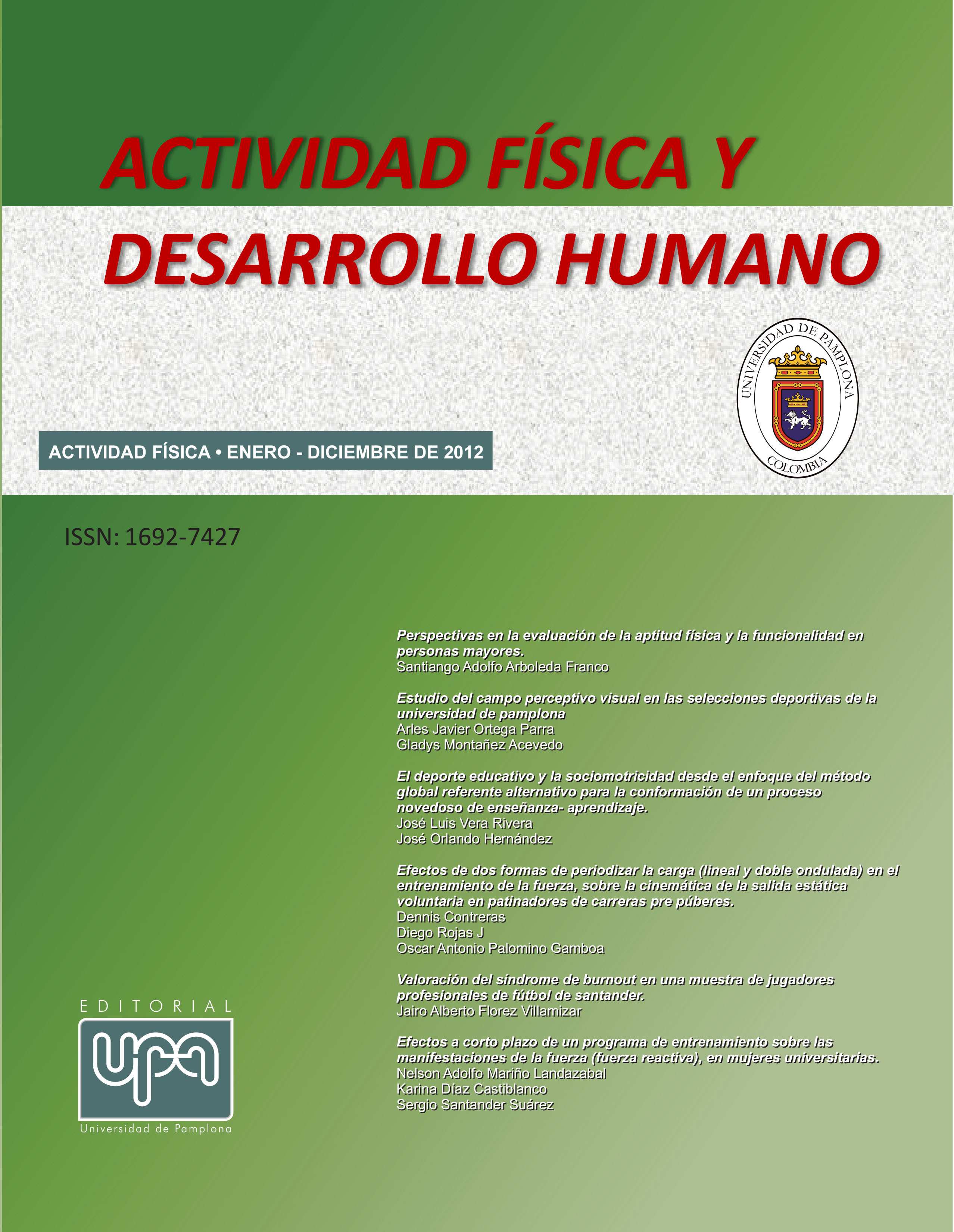Tipología de la región plantar, influyente en la actividad física, de los deportistas en formación del club norte patín en línea de la ciudad de Cúcuta
DOI:
https://doi.org/10.24054/afdh.v4i1.1720Palabras clave:
Biomecánica, tipología de pie, patinajeResumen
La medición y estudio de las estructuras del cuerpo humano y su incidencia en el rendimiento deportivo, se ha consolidado como una gran área de estudios en las ciencias aplicadas a la actividad física y el deporte. En mención a lo anterior, la presente inves- tigación surgió con el objetivo de conocer indicadores tipológicos de los deportistas de patinaje de carreras del club Norte Patín de la ciudad de Cúcuta. Para ello, se aplicó un estudio de la huella plantar siguiendo el protocolo de Hernández Corvo. La población de estudio estuvo conformada por 15 deportistas de ambos sexo perteneciente al Club Norte Patín, divididos en 3 grupos: dos de sexo femenino discriminados por la edad, donde el primer grupo está conformado por 7 patinadores con un promedio de edad de 7.7 años; el segundo con 5 patinadores con un promedio de 12 años, y el tercer grupo, de sexo masculino con 3 patinadores con un promedio de edad de 7.7 años.
Las pruebas aplicadas permitieron establecer el estudio de índice tipológico de pie (Hernández Corvo, 1987) de la población objeto de estudio.La implementación de análisis estadístico posibilitó conocer el comportamiento de las variables a nivel individual y de grupo por sexo; adicionalmente, comparar los resultados de variables de estudio entre los grupos evaluados en busca de establecer diferencias significativas entre las mismas. Se ofrece a la comunidad académica los resultados obtenidos y los protocolos de medición implementados, para su uso y difusión con fines de contribuir en el dispendioso y complejo proceso del entrenamiento deportivo.
Descargas
Referencias
Acero, J. (2002). Cineantropometría (pp. 141–144). Cali: Faid Editores.
Acero, J., & Albarracín, J. (2005). Biomecánica bidimensional (2D) del tiro libre preferencial en fútbol: un modelo integral experimental (progreso 1).
Acero, J., & Palomino, A. (2010). Modelo de evaluación y control biomecánico (Biomin-Patín) en el entrenamiento de los patinadores de carreras. Recuperado de http://www.spagatta.com (revisión realizada en julio de 2012).
Barajas, Y. (2007). Efectividad de un programa individualizado de optimización de la técnica (PIOT) basado en un análisis antropo-cinemático del tiro libre preferencial (TLP) en jugadores de la selección de fútbol de la Universidad de Pamplona, Colombia.
Gómez Salazar, L. L., Herrera, M. J., & Villalba Villaiva, A. (2007). Factores de riesgo posturales dinámicos y de la ejecución técnica para lesiones osteomusculares en levantadores de pesas. Educación Física y Deporte, (61), 6–9.
González Gil, J. M. (2008). El pie cavo. Recuperado el 18 de mayo de 2008 de http://consultas.cuba.cu/consultas.php?ini=p&ord=13
Hernández Corvo, R. (1987). Morfología funcional deportiva. La Habana: Científico-Técnica.
Hernández Corvo, R. (2000). Morfología funcional deportiva: Sistema locomotor. Revista Internacional de Medicina y Ciencias de la Actividad Física y el Deporte, 80(2).
Hernández Guerra, R. H. (2006). Prevalencia del pie plano en niños y niñas en las edades de 9 a 12 años. Revista Internacional de Medicina y Ciencias de la Actividad Física y el Deporte, 6(23), 165–172. http://cdeporte.rediris.es/revista/revista23/artpieplano.htm
Lozano, Z. R. E. (2005). Perfil fisiológico del patinador de velocidad sobre ruedas por medio de un protocolo de esfuerzo máximo en el laboratorio. Revista CLON, 3(1). Universidad de Pamplona.
Negrín Pérez, R. (2001). El pie, su importancia en la función de apoyo y su relación con la actividad física.
Pérez Duvergel, F. (2008). El pie plano. Recuperado el 28 de mayo de 2008 de http://consultas.cuba.cu/consultas.php?ini=p&ovestird=15
Ramos Parraci, C. A., & López Laiseca, J. D. (2009). Centro de gravedad biplanal durante un programa de rehabilitación neuromuscular propioceptiva en levantadores de pesas. Revista Edu-Física, 1(4).
Weineck, J. (2004). La anatomía deportiva (2.ª ed., pp. 222–223). Barcelona: Paidotribo.
Descargas
Publicado
Número
Sección
Licencia
Derechos de autor 2012 ACTIVIDAD FÍSICA Y DESARROLLO HUMANO

Esta obra está bajo una licencia internacional Creative Commons Atribución-NoComercial-SinDerivadas 4.0.











